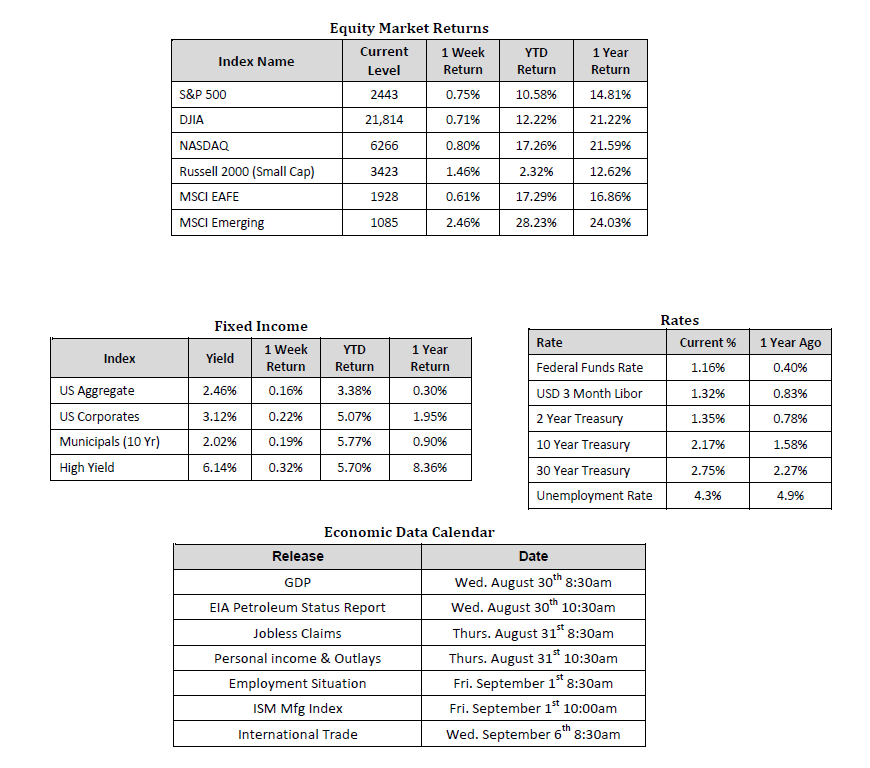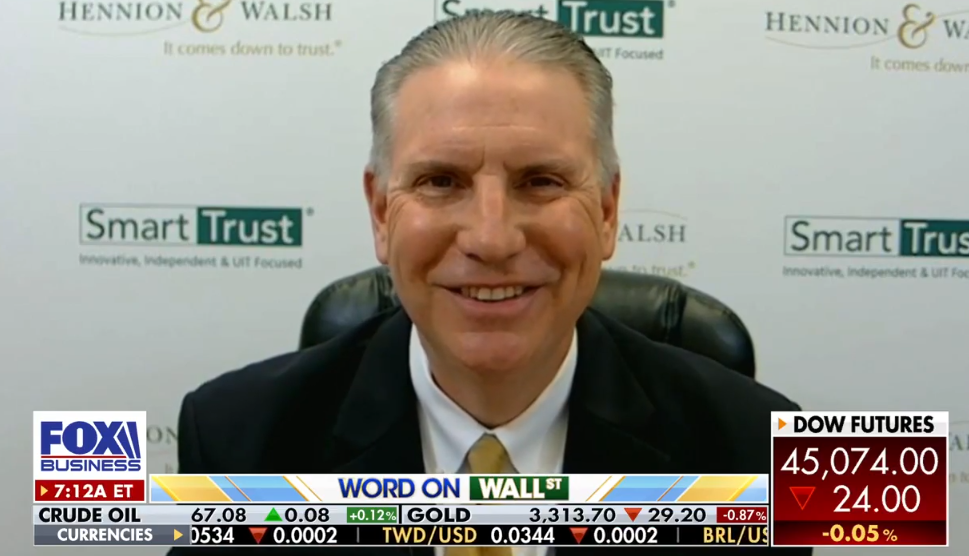
U.S. Stock Mutual Fund Withdrawals Accelerate
Market Overview

Sources: Sources for data in tables: Equity Market and Fixed Income returns are from JP Morgan as of 8/25/17. Rates and Economic Calendar Data from Bloomberg as of 8/29/17. International developed markets measured by the MSCI EAFE Index, emerging markets measured by the MSCI EM Index. Sector performance is measured using GICS methodology. S&P 500 earnings data from Factset as of 8/25/17.
Happening Now
U.S. stocks rebounded last week following two consecutive weeks of heightened volatility and negative returns. The S&P 500 Index gained 0.8% while the Russell Midcap Index climbed 1.1% and the Russell 2000 Index, a gauge of small cap companies, moved 1.5% higher. Internationally, developed markets advanced 0.6% while emerging markets gained 2.5%. While stocks globally have generated higher than historically average returns thus far in 2017, emerging markets outpaced other geographic regions by a wide margin – up nearly 30% year-to-date!
The U.S. stock market has exhibited terrific performance so far this year, both in terms of absolute and risk-adjusted returns. Volatility has held at an unprecedented level for the majority of 2017 and returns so far this year are above long term historical averages. Despite this solid showing, U.S. stock mutual funds have experienced four consecutive weeks of outflows and withdrawals appear to being picking up steam. The latest data from the Investment Company Institute shows that during the seven day period between August 9 and August 16, investors withdrew $9.9 billion from domestic equity mutual funds, a 92% jump versus the prior week. In addition to withdrawals from U.S. stock mutual funds, exchange traded funds (ETFs) also saw investors pull funds to the tune of a $2 billion withdrawal during the same seven day time period.
While U.S. stock funds have experienced withdrawals recently, it is worth noting that international stock funds have had five consecutive weeks of inflows. On the surface, it is encouraging to see investors embracing international stocks and diversifying outside of the U.S. We understand, however, the tendency for investors to chase returns and warn that buying what has done well simply because it has done well recently is, in effect, “buying high”. We contend that it is far better to make purchase and sale decisions based on the merits of a given security or asset class and the outlook for future, not past, returns.
We do not believe that it is necessarily time to “de-risk” your portfolio. In our view, this particular business cycle is still in an expansionary phase consisting of synchronized global economic growth, accommodative financial conditions, and healthy corporate profits. Despite the mild increase in volatility, investors should try to resist the urge to follow the herd and should not turn their backs on U.S. stocks. Based upon an investor’s tolerance for risk, financial objectives and investment timeframe, it is likely still prudent to maintain a disciplined allocation to U.S. stocks as part of a diversified portfolio.
Important Information and Disclaimers
Disclosures: Hennion & Walsh is the sponsor of SmartTrust® Unit Investment Trusts (UITs). For more information on SmartTrust® UITs, please visit www.smarttrustuit.com. The overview above is for informational purposes and is not an offer to sell or a solicitation of an offer to buy any SmartTrust® UITs. Investors should consider the Trust’s investment objective, risks, charges and expenses carefully before investing. The prospectus contains this and other information relevant to an investment in the Trust and investors should read the prospectus carefully before they invest.
Investing in foreign securities presents certain risks not associated with domestic investments, such as currency fluctuation, political and economic instability, and different accounting standards. This may result in greater share price volatility. These risks are heightened in emerging markets.
There are special risks associated with an investment in real estate, including credit risk, interest rate fluctuations and the impact of varied economic conditions. Distributions from REIT investments are taxed at the owner’s tax bracket.
The prices of small company and mid cap stocks are generally more volatile than large company stocks. They often involve higher risks because smaller companies may lack the management expertise, financial resources, product diversification and competitive strengths to endure adverse economic conditions.
Investing in commodities is not suitable for all investors. Exposure to the commodities markets may subject an investment to greater share price volatility than an investment in traditional equity or debt securities. Investments in commodities may be affected by changes in overall market movements, commodity index volatility, changes in interest rates or factors affecting a particular industry or commodity.
Products that invest in commodities may employ more complex strategies which may expose investors to additional risks.
Investing in fixed income securities involves certain risks such as market risk if sold prior to maturity and credit risk especially if investing in high yield bonds, which have lower ratings and are subject to greater volatility. All fixed income investments may be worth less than original cost upon redemption or maturity. Bond Prices fluctuate inversely to changes in interest rates. Therefore, a general rise in interest rates can result in the decline of the value of your investment.
Definitions
MSCI- EAFE: The Morgan Stanley Capital International Europe, Australasia and Far East Index, a free float-adjusted market capitalization index that is designed to measure developed-market equity performance, excluding the United States and Canada.
MSCI-Emerging Markets: The Morgan Stanley Capital International Emerging Market Index, is a free float-adjusted market capitalization index that is designed to measure the performance of global emerging markets of about 25 emerging economies.
Russell 3000: The Russell 3000 measures the performance of the 3000 largest US companies based on total market capitalization and represents about 98% of the investible US Equity market.
ML BOFA US Corp Mstr [Merill Lynch US Corporate Master]: The Merrill Lynch Corporate Master Market Index is a statistical composite tracking the performance of the entire US corporate bond market over time.
ML Muni Master [Merill Lynch US Corporate Master]: The Merrill Lynch Municipal Bond Master Index is a broad measure of the municipal fixed income market.
Investors cannot directly purchase any index.
LIBOR, London Interbank Offered Rate, is the rate of interest at which banks offer to lend money to one another in the wholesale money markets in London.
The Dow Jones Industrial Average is an unweighted index of 30 “blue-chip” industrial U.S. stocks.
The S&P Midcap 400 Index is a capitalization-weighted index measuring the performance of the mid-range sector of the U.S. stock market, and represents approximately 7% of the total market value of U.S. equities. Companies in the Index fall between S&P 500 Index and the S&P SmallCap 600 Index in size: between $1-4 billion.
DJ Equity REIT Index represents all publicly traded real estate investment trusts in the Dow Jones U.S. stock universe classified as Equity REITs according to the S&P Dow Jones Indices REIT Industry Classification Hierarchy. These companies are REITSs that primarily own and operate income-producing real estate.



